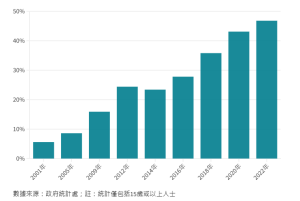
[E-commerce Insights] Global Surge in Online Shopping: Understanding B2B, B2C, and B2B2C Business Models through Examples
Publish Date:2023-07-29

E-commerce and online shopping—what are they exactly?
‘Transactions and consumer shopping behavior conducted on the Internet.’
Thinking back to the era before online shopping became widespread, how did people engage in consumer activities? In the editor’s younger years, shopping typically involved physically going to supermarkets, convenience stores, brick-and-mortar stores, or department stores. However, with the popularity of the Internet, online shopping began to rise, and people realized that shopping didn’t necessarily require a visit to a store; instead, they could easily purchase the desired products online, leading to a transformation in consumer scenarios and habits.

E-commerce, short for Electronic Commerce, refers to commercial transactions conducted on the Internet. Since the 1990s, e-commerce giants like eBay, Amazon, Rakuten, Alibaba, and others have emerged, gradually being seen as a trend in the retail industry.
Although the umbrella term for business transactions on the Internet is e-commerce, it can be categorized into four main models based on different sales channels and target audiences:
- B2B (Business-to-Business): Both the seller and the buyer are businesses. Examples include wholesalers to retailers, manufacturers to distributors, and raw material suppliers to brand manufacturers. Prominent B2B e-commerce platforms include Alibaba and Amazon Business.
- B2C (Business-to-Consumer): Direct sales from businesses to end consumers. Examples include consumers ordering iPhones through the Apple website or purchasing clothing from the Nike online store.
- B2B2C (Business-to-Business-to-Consumer): This sales model usually involves an intermediary “platform” where businesses place their products, and end consumers make purchases through the platform. Well-known platforms include HKTVMall, Ztore, YOHO, Shopee, Lazada, and others.
- C2C (Consumer-to-Consumer): Transactions between consumers, such as selling personal items on platforms like Carousell, Facebook Marketplace, Instagram shops, and others.
The Trend of Continuous Growth in Online Shopping: Are You Keeping Up? While the concept of “e-commerce” has been around for many years, according to statistics and forecasts released by eMarketer in early 2021, e-commerce continues to show a trend of sustained growth. It is estimated that by 2024, global e-commerce sales will reach nearly $6.4 trillion (approximately HKD 50 trillion), accounting for one-fifth of the total retail industry sales.
2019-2024 Global e-Commerce Sales

Focusing on the Hong Kong market, according to data from the Census and Statistics Department, the proportion of individuals aged 15 and above who engaged in online shopping increased from 35.8% in 2018 to 46.8% in 2022. Among them, individuals aged 25 to 34 have the highest online shopping rate, reaching 80%. Mainly purchased items online include daily necessities, clothing and footwear (82.9%), food and beverages (43.4%), take-out food (37.9%), and ticket bookings (11.6%).
Proportion of Online Shoppers in Hong Kong, 2001-2022

Looking at data globally and locally, e-commerce remains a continually growing industry. In this ongoing wave of e-commerce growth, as an online merchant or business manager, you may have deeply experienced the convenience and opportunities brought by online shopping. However, with the continuous expansion of your business, you may also begin to face some challenges, especially in warehouse operations and logistics management.
Here, we are pleased to introduce DBEE’s Cloud Warehouse Management Service, a solution crafted by our team based on extensive experience in e-commerce, logistics, and software development. We understand that for small and medium-sized enterprises, establishing an efficient supply chain is a key challenge, especially when you want to focus on developing your core business and expanding your business territory.
DBEE’s Cloud Warehouse Management Service aims to simplify everything. Whether you operate in a B2B, B2C, or B2B2C model, and regardless of whether you are a large enterprise or a startup, we can provide personalized support. Drawing inspiration from Amazon’s Fulfillment By Amazon (FBA) model, we enable you to concentrate on the high-value aspects of your business, such as the products themselves and sales promotion, while entrusting us to handle the intricate warehouse operations and logistics.

Whether you have a self-built online store or conduct business on different sales platforms simultaneously, we can offer personalized cloud warehouse management solutions, ensuring your inventory reaches consumers in a timely manner. You can easily monitor inventory status, arrange orders, track logistics information in real-time, and enjoy the convenience of a digital nomadic lifestyle anytime, anywhere. Moreover, all of this is based on a cloud-based business management that not only streamlines operations but also helps you eliminate fixed costs, making your business more competitive.
At DBEE, our vision is to empower small and medium-sized enterprises with top-tier e-commerce supply chain support. We understand that your success is our success, and thus, we are committed to providing the best cloud warehouse management solutions to help you achieve your business goals and dreams. Let’s collaborate and build a high-quality e-commerce supply chain, paving the way for broader development. If you have any questions, feel free to contact our operations consultants or visit www.dbee.hk for more information. We are here to serve you wholeheartedly.


![[E-commerce Insights] New to Online Retail? 4 Key E-commerce Tips](https://www.dbee.hk/wp-content/uploads/2023/07/3.1-1080x675.png)
[E-commerce Insights] New to Online Retail? 4 Key E-commerce Tips
![[E-commerce Insights] Seize Opportunities! 5 Advantages and 1 Challenge in Running an Online Store](https://www.dbee.hk/wp-content/uploads/2023/07/2.1-1080x675.webp)
[E-commerce Insights] Seize Opportunities! 5 Advantages and 1 Challenge in Running an Online Store

DBEE Cloud Warehouse Summer Special 2023!
Chill with the AC, glance at your computer, and let the orders practically handle themselves.Promotion Period: July 1 -...

![[E-commerce Insights] New to Online Retail? 4 Key E-commerce Tips](https://www.dbee.hk/wp-content/uploads/2023/07/3.1.png)
![[E-commerce Insights] Seize Opportunities! 5 Advantages and 1 Challenge in Running an Online Store](https://www.dbee.hk/wp-content/uploads/2023/07/2.1-jpg.webp)
0 Comments